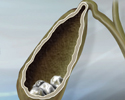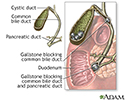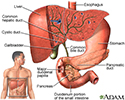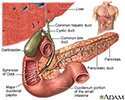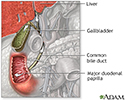Choledocholithiasis
Gallstone in the bile duct; Bile duct stone
Choledocholithiasis is the presence of at least one gallstone in the common bile duct. The stone may be made up of bile pigments or calcium and cholesterol salts.
Causes
About 1 in 7 people with gallstones will develop stones in the common bile duct. This is the small tube that carries bile from the gallbladder to the intestine.
Risk factors include a history of gallstones. However, choledocholithiasis can occur in people who have had their gallbladder removed.
Symptoms
Often, there are no symptoms unless the stone blocks the common bile duct. Symptoms may include:
- Pain in the right upper or middle upper abdomen for at least 30 minutes. The pain may be constant and intense. It can be mild or severe.
- Fever.
- Yellowing of skin and whites of the eyes (jaundice).
- Loss of appetite.
- Nausea and vomiting.
- Clay-colored stools.
Exams and Tests
Tests that show the location of stones in the bile duct include the following:
- Abdominal CT scan
- Abdominal ultrasound
- Endoscopic retrograde cholangiography (ERCP)
- Endoscopic ultrasound
- Magnetic resonance cholangiopancreatography (MRCP)
- Percutaneous transhepatic cholangiogram (PTCA)
Your health care provider may order the following blood tests:
- Bilirubin
- Complete blood count (CBC)
- Liver function tests
- Pancreatic enzymes
Treatment
The goal of treatment is to relieve the blockage.
Treatment may involve:
- Surgery to remove the gallbladder and stones
- ERCP and a procedure called a sphincterotomy, which makes a surgical cut into the muscle in the common bile duct to allow stones to pass or be removed
Outlook (Prognosis)
Blockage and infection caused by stones in the biliary tract can be life threatening. Most of the time, the outcome is good if the problem is detected and treated early.
Possible Complications
Complications may include:
- Biliary cirrhosis
- Cholangitis
- Pancreatitis
When to Contact a Medical Professional
Call your provider if:
- You develop abdominal pain, with or without fever, and there is no known cause
- You develop jaundice
- You have other symptoms of choledocholithiasis
References
Fogel EL, Sherman S. Diseases of the gallbladder and bile ducts. In: Goldman L, Schafer AI, eds. Goldman-Cecil Medicine. 26th ed. Philadelphia, PA: Elsevier; 2020:chap 146.
Li S, Zenlea T. Choledocholithiasis. In: Ferri FF, ed. Ferri's Clinical Advisor 2022. Philadelphia, PA: Elsevier; 2022:368-369.
Radkani P, Hawksworth J, Fishbein T. Biliary system. In: Townsend CM Jr, Beauchamp RD, Evers BM, Mattox KL, eds. Sabiston Textbook of Surgery. 21st ed. Philadelphia, PA: Elsevier; 2022:chap 55.
Gallstones
Animation
Digestive system - illustration
Digestive system
illustration
Kidney cyst with gallstones - CT scan - illustration
Kidney cyst with gallstones - CT scan
illustration
Choledocholithiasis - illustration
Choledocholithiasis
illustration
Gallbladder - illustration
Gallbladder
illustration
Gallbladder - illustration
Gallbladder
illustration
Bile pathway - illustration
Bile pathway
illustration
Digestive system - illustration
Digestive system
illustration
Kidney cyst with gallstones - CT scan - illustration
Kidney cyst with gallstones - CT scan
illustration
Choledocholithiasis - illustration
Choledocholithiasis
illustration
Gallbladder - illustration
Gallbladder
illustration
Gallbladder - illustration
Gallbladder
illustration
Bile pathway - illustration
Bile pathway
illustration
Review Date: 4/20/2021
Reviewed By: Michael M. Phillips, MD, Emeritus Professor of Medicine, The George Washington University School of Medicine, Washington, DC. Also reviewed by David Zieve, MD, MHA, Medical Director, Brenda Conaway, Editorial Director, and the A.D.A.M. Editorial team.











